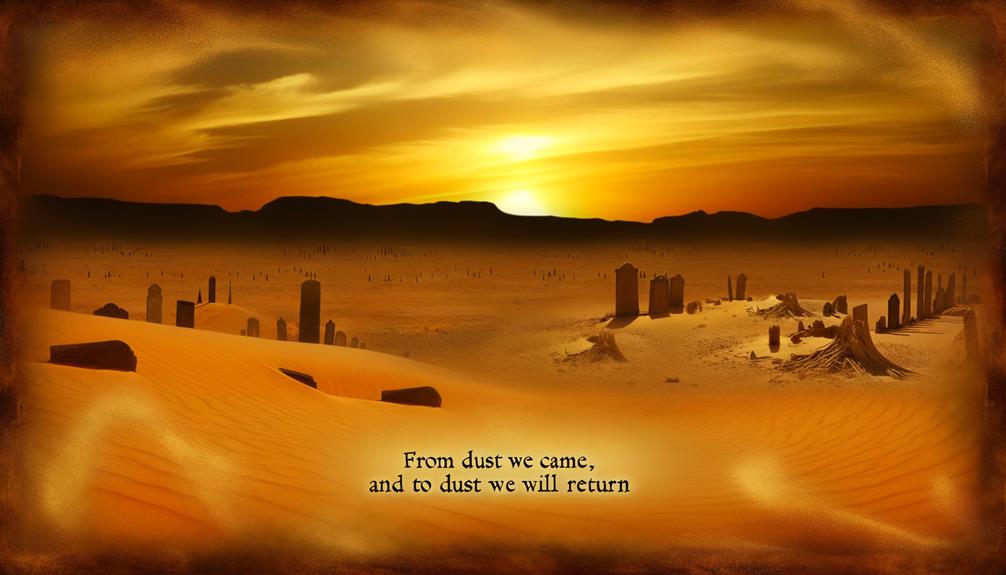Dust Meaning in the Bible: Mortality and Humility
In the Bible, dust symbolizes both the humble origins and the transient nature of human life. Genesis 2:7 depicts God forming man from the dust, highlighting divine creation and our connection to the earth.
Dust further underscores human mortality, as reflected in the phrase “dust to dust” from Genesis 3:19. It represents humility, repentance, and mourning, with figures like Job expressing sorrow and contrition in dust and ashes.
Additionally, prophetic literature uses dust to convey divine judgment and human frailty. This concept encapsulates themes of human limitations and divine sovereignty, opening deeper reflections on spiritual humility and renewal.

Dust Meaning in the Bible: Symbolism of Humility, Mortality, and Creation
| Concept | Biblical Interpretation | Key Verses |
|---|---|---|
| Human Origin | Man formed from the dust of the ground | Genesis 2:7 |
| Mortality and Death | “Dust you are, and to dust you shall return” | Genesis 3:19 |
| Humility and Repentance | Dust as a symbol of lowliness and contrition | Job 42:6, Isaiah 58:5 |
| God’s Sovereignty | Dust shows God’s power to create and restore | Ecclesiastes 3:20, Psalm 103:14 |
| Abundance or Multitude | Dust used to signify countless descendants | Genesis 13:16, Genesis 28:14 |
Creation of Adam

How does the biblical narrative describe the use of dust in the creation of Adam?
In Genesis 2:7, the Bible states, ‘Then the Lord God formed a man from the dust of the ground and breathed into his nostrils the breath of life, and the man became a living being‘ (NIV).
This verse highlights dust as the essential material through which God initiates human life. It signifies the divine act of creation where inert matter transforms into a living soul by God’s breath.
The use of dust underscores humanity’s fundamental connection to the earth, emphasizing that life’s origin is both humble and sacred.
This passage invites contemplation on the intimate interplay between the divine and the terrestrial in the act of creation.
Symbol of Humility

In biblical literature, dust serves as a poignant symbol of humility, encapsulating themes such as ‘ashes to ashes,’ mourning, and repentance, as well as a reminder of humanity’s earthly origin.
These motifs collectively underscore the transient nature of human life and the necessity of humility before the divine.
Through various scriptural passages, dust conveys the profound understanding of human limitation and dependence on God.
Ashes to Ashes
The phrase ‘Ashes to ashes, dust to dust,’ often recited during Christian burial rites, profoundly encapsulates the biblical symbolism of humility and the human condition.
Rooted in Genesis 3:19, it underscores humanity’s creation from the earth and inevitable return to it, emphasizing our transient existence. This poignant reminder of mortality fosters a sense of humility, as it reveals the temporal nature of worldly achievements and possessions.
In Scripture, dust symbolizes human frailty, while ashes often denote purification and renewal. Collectively, ‘ashes to ashes’ serves as a humbling acknowledgment of our origin and destiny, encouraging reverence and humility before God.
It calls for a recognition of our dependence on divine mercy and grace, underscoring the ephemeral nature of human life.
Mourning and Repentance
Demonstrating profound humility, the act of covering oneself in dust and ashes throughout biblical narratives serves as a potent symbol of mourning and repentance.
This practice, vividly illustrated in the stories of Job (Job 42:6) and the inhabitants of Nineveh (Jonah 3:6), signifies an individual’s recognition of their own frailty and sinfulness before God.
By donning dust and ashes, penitents express a deep sorrow for their transgressions and a genuine desire for divine forgiveness.
This ritualistic gesture underscores the humility required to seek reconciliation with the Almighty, while also acknowledging one’s limitations and need for divine grace.
Such symbolic acts are deeply embedded in the cultural and religious fabric of ancient Israel, reflecting a universal human experience of contrition and renewal.
Earthly Origin Reminder
Beyond its role in mourning and repentance, the symbolism of dust in the Bible also serves as a poignant reminder of humanity’s earthly origin and inherent humility. This symbolism is deeply embedded within the biblical narrative, emphasizing the transient and fragile nature of human life.
The following points elucidate this concept:
- Creation of Man: Genesis 2:7 recounts that God formed man from the dust of the ground, highlighting our humble beginnings.
- Human Frailty: Psalm 103:14 acknowledges, ‘For He knows our frame; He remembers that we are dust,’ underscoring our vulnerability.
- Mortality: Ecclesiastes 3:20 reflects on the inevitable return to dust, signifying life’s temporal nature.
- Humility: Job 30:19 illustrates dust as a metaphor for humility and lowliness in human existence.
Mortality and Death

The biblical phrase ‘from dust you are and to dust you shall return’ poignantly encapsulates the transient nature of human life, emphasizing mortality and the inevitable return to the earth.
This imagery serves as a humbling reminder of humanity’s ephemeral existence and ultimate dependence on God’s grace.
From Dust, Return
In biblical literature, the phrase ‘from dust, return’ poignantly encapsulates the transient nature of human life and the inevitability of death. This concept is rooted in several key scriptural references:
- Genesis 3:19 – ‘For dust you are and to dust you will return,’ highlighting the divine decree post-Fall.
- Ecclesiastes 3:20 – ‘All go to one place; all are from the dust, and to dust all return,’ emphasizing life’s cyclical nature.
- Psalm 104:29 – ‘When you hide your face, they are dismayed; when you take away their breath, they die and return to their dust,’ reflecting God’s control over life and death.
- Job 34:15 – ‘All flesh would perish together, and man would return to dust,’ illustrating human mortality within divine judgment.
These verses underscore the temporality of existence and the solemn return to one’s origin.
Symbol of Humility
Acknowledging the transient nature of human existence, biblical references to dust also serve as a powerful symbol of humility, reminding believers of their mortality and ultimate return to the earth.
Scriptural passages, such as Genesis 3:19—’for dust you are and to dust you will return’—underscore the finite span of human life. This acknowledgment cultivates a sense of humility, prompting individuals to recognize their dependence on divine providence.
In Ecclesiastes 3:20, this theme is reiterated: ‘All go to the same place; all come from dust, and to dust all return.’ Such passages elevate the concept of dust beyond mere physicality, framing it as a spiritual reminder that human life, though fleeting, holds profound significance within the divine order.
Dust to Dust

From the earliest passages of Scripture, the phrase ‘dust to dust’ encapsulates a profound theological assertion about human mortality and the transient nature of earthly life. This concept is deeply embedded in biblical theology, underscoring key aspects of human existence:
- Creation: Humanity is formed from dust, as depicted in Genesis 2:7, symbolizing our humble origins.
- Mortality: Genesis 3:19 poignantly states, ‘for dust you are and to dust you will return,’ highlighting human finitude.
- Judgment: The return to dust serves as a reminder of divine judgment and the consequences of sin.
- Hope: Despite our mortality, the Bible offers hope beyond dust through resurrection and eternal life.
This perspective invites a contemplative reflection on life’s ephemeral nature and divine purpose.
Dust and Repentance

The symbolism of dust in biblical texts extends to themes of repentance, where it signifies human contrition and the earnest seeking of divine mercy. This imagery is evident in passages like Job 42:6, where Job declares, ‘I despise myself and repent in dust and ashes.’
Here, dust serves as a visual manifestation of humility and acknowledgment of one’s sins before God. The act of covering oneself in dust or sitting in it is not merely a cultural practice but a profound spiritual gesture.
It underscores the believer’s recognition of their own mortality and fallibility, reinforcing their dependence on God’s grace. Therefore, dust, in its biblical context, becomes a powerful symbol of penitence and the transformative journey towards redemption.
Symbol of Mourning

In biblical literature, dust emerges as a poignant symbol of mourning, reflecting the depth of human grief and loss. This metaphor is employed in various contexts to illustrate the sorrow and despondency that accompany significant emotional and spiritual experiences.
Key instances include:
- Job’s Lamentation: Job 2:12-13 describes Job sitting in ashes and dust as he mourns his immense suffering and loss.
- David’s Mourning: In 2 Samuel 13:19, Tamar places ashes on her head, a sign of mourning after a grievous event.
- Communal Grief: Nehemiah 9:1 depicts the Israelites covering themselves in dust as a collective expression of penitence and sorrow.
- Prophetic Acts: Jeremiah 6:26 calls for mourning akin to the deep lamentation of wearing sackcloth and rolling in ashes.
These examples underscore dust as a profound symbol of mourning in biblical texts.
Prophetic Imagery

Dust, within the domain of prophetic imagery, serves as a potent symbol to convey messages of divine judgment and human frailty.
Biblical prophets often employed the motif of dust to illustrate the transient nature of human existence and the consequences of turning away from God. For instance, in Isaiah 47:1, the imagery of sitting in the dust underscores Babylon’s impending downfall and humiliation.
Similarly, the prophetic declaration in Ezekiel 26:16, where princes of the sea sit on the ground in dust, epitomizes utter desolation and defeat. This usage encapsulates the theological perspective that all human achievements are ultimately ephemeral, reinforcing the need for humility and repentance.
Consequently, dust becomes a profound emblem in the prophetic lexicon, evoking both existential vulnerability and divine retribution.
God’s Sovereignty

Recognizing the symbolic potency of dust in prophetic imagery naturally leads to a deeper appreciation of God’s sovereignty, which orchestrates the grand narrative of redemption and judgment throughout the scriptures. This sovereignty is evident in several key theological aspects:
- Creation: God’s formation of humanity from dust (Genesis 2:7) underscores His creative authority.
- Judgment: The return to dust (Genesis 3:19) symbolizes divine judgment and mortality.
- Humility: Dust signifies human frailty and dependence on God (Psalm 103:14).
- Restoration: The transformation from dust to glory (1 Corinthians 15:42-44) illustrates divine redemption.
Each instance of dust imagery not only highlights human limitations but also magnifies God’s omnipotent role in the cosmic order.
Dust in Psalms

The Psalms frequently employ the motif of dust to convey themes of human fragility, divine compassion, and the transient nature of earthly existence.
For instance, Psalm 103:14 acknowledges, ‘For He knows our frame; He remembers that we are dust.’ This verse underscores the Creator’s intimate awareness of human limitations and frailty.
Additionally, Psalm 22:15 poignantly reflects on suffering by stating, ‘You lay me in the dust of death,’ highlighting the proximity of mortality.
Conversely, the psalmist’s plea in Psalm 119:25, ‘My soul clings to the dust; revive me according to Your word,’ illustrates a yearning for divine intervention and renewal.
Accordingly, dust serves as a profound metaphor for human vulnerability and the need for divine sustenance.
Dust in Ecclesiastes

In the book of Ecclesiastes, the concept of dust serves as a poignant reminder of human mortality and the inevitable return to the earth from which life originates.
Ecclesiastes eloquently weaves this theme throughout its philosophical discourse, emphasizing the transient nature of human existence.
Significantly, several verses underscore this idea:
- Ecclesiastes 3:20 – ‘All go to one place; all are from the dust, and to dust all return.’
- Ecclesiastes 12:7 – ‘And the dust returns to the earth as it was, and the spirit returns to God who gave it.’
- Human Equality – Both rich and poor share the same fate.
- Impermanence – Earthly pursuits are ultimately fleeting.
These passages reinforce the universal truth of life’s ephemeral nature.
Resurrection and New Life

In the biblical narrative, dust frequently symbolizes the mortality and frailty of human existence, yet it is within this very dust that the transformative power of God manifests most profoundly.
Through the promise of resurrection and new life, Scripture reveals a divine capacity to transcend the limitations of the earthly and temporal, offering an eternal hope grounded in divine omnipotence.
This juxtaposition underscores the theological premise that from the dust, new life emerges, embodying the ultimate victory over death.
Biblical Dust Symbolism
Biblical references to dust often symbolize the profound themes of resurrection and new life, underscoring humanity’s cyclical journey from creation to redemption. The symbolism of dust is multifaceted, reflecting various theological dimensions:
- Creation of Man: Genesis 2:7 portrays God forming Adam from the dust, signifying the divine origin and inherent dignity of human life.
- Human Mortality: Ecclesiastes 3:20 reminds us that all return to dust, emphasizing life’s temporality and the inevitability of death.
- Resurrection Hope: Isaiah 26:19 and Daniel 12:2 speak of awakening from the dust, symbolizing resurrection and eternal life.
- Renewal and Purification: Job 42:6 demonstrates repentance in dust and ashes, representing spiritual renewal and purification.
This cyclical motif of dust illustrates the profound connection between physical life, death, and spiritual rebirth.
Transformative Divine Power
The profound symbolism of dust naturally extends into the transformative divine power manifest in resurrection and new life, encapsulating the essence of spiritual renewal and eternal hope.
In biblical narratives, dust signifies human mortality, yet it is through divine intervention that this dust is transformed, illustrating profound theological truths.
Genesis 2:7 reveals humanity’s creation from dust, while Ezekiel 37’s vision of dry bones illustrates God’s power to bring life from what is lifeless.
The resurrection of Jesus Christ epitomizes this transformation, as He rose from the grave, symbolizing victory over death and the promise of new life.
Therefore, dust, initially a symbol of finitude, becomes a profound witness to divine power and the potential for spiritual rejuvenation.
Eternal Hope Promise
Resurrection and new life stand as the ultimate evidence to the promise of eternal hope within Christian theology, epitomizing the transformative power of divine intervention. This profound belief underscores several key aspects:
- Scriptural Foundation: The resurrection of Jesus Christ, as detailed in the Gospels, serves as the cornerstone of Christian faith, affirming the possibility of life beyond death.
- Theological Implications: It signifies victory over sin and death, offering believers assurance of their own resurrection.
- Spiritual Renewal: The concept of new life through resurrection emphasizes a transformative spiritual rebirth, aligning with the theme of redemption.
- Eschatological Hope: It provides a forward-looking promise of eternal life, fostering hope and perseverance among the faithful in their spiritual journey.
In essence, resurrection embodies the divine promise of eternal hope and renewal.
Conclusion
In biblical literature, ‘dust’ functions as a versatile symbol, embodying creation, humility, mortality, repentance, and divine sovereignty.
From the creation of Adam from dust to the solemn reminder of ‘dust to dust,’ these references underscore human frailty and the transient nature of earthly life.
The imagery serves as a poignant metaphor, highlighting the interplay between human vulnerability and divine omnipotence, ultimately pointing to the hope of resurrection and new life.
Consequently, dust remains a profound theological motif.






